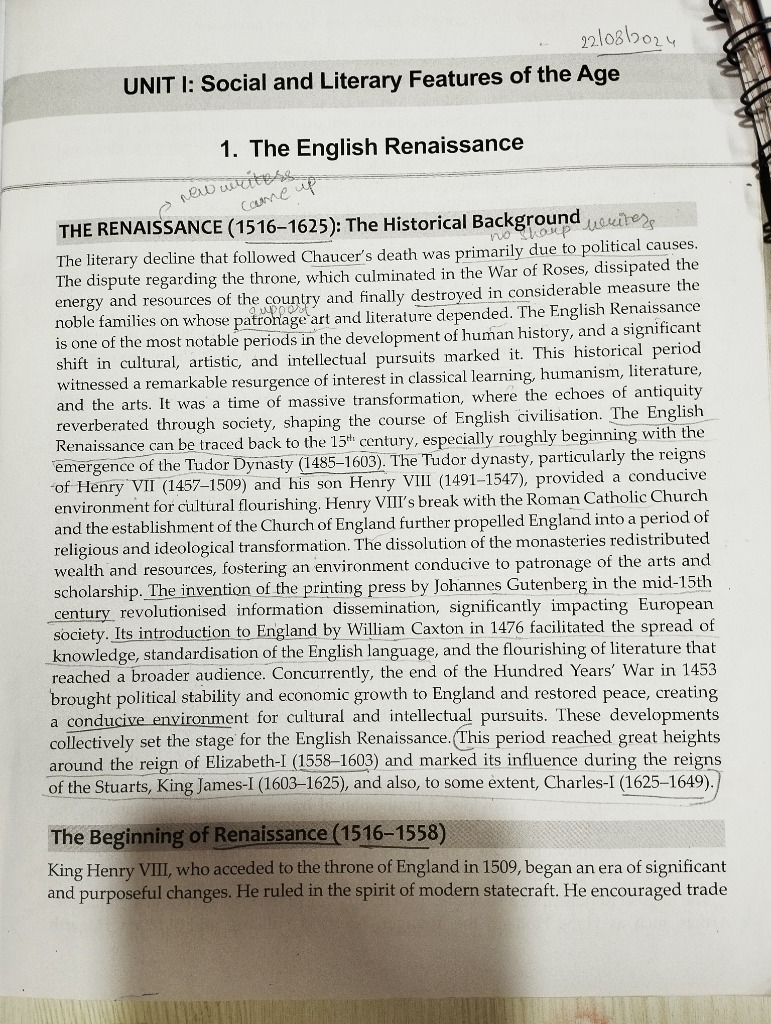The English Renaissance: Key Historical Insights
The English Renaissance: Historical Background Notes

Overview of the Renaissance (1516-1625)
-
Significance of the Period: The English Renaissance is recognized as a pivotal era in human history, witnessing profound transformations in culture, art, and intellectual pursuits.
- Thoughts: This transformation laid the groundwork for modern Western culture and is marked by a revival of classical knowledge and arts.
-
Political Context: The literary decline post-Chaucer was influenced by political instability, notably the War of Roses, which drained resources and impacted noble patronage of the arts and literature.
- Additional Info: Understanding the political backdrop can help explain the fluctuations in cultural output during this time.
Key Factors Influencing the Renaissance
-
Emergence of the Tudor Dynasty (1485-1603) : The rise of this dynasty facilitated a shift towards a more stable political environment, promoting the arts and literature.
- Thoughts: Stable governance can lead to flourishing cultural expressions, as seen during the Tudor reign.
-
King Henry VIII's Role: His reign from 1509 marked significant social and political changes that fostered a conducive environment for the Renaissance.
- Additional Info: Henry VIII's break with the Catholic Church not only transformed religion in England but also had far-reaching effects on culture and the arts.
Technological Advancements
-
Invention of the Printing Press: Introduced by Johannes Gutenberg in the mid-15th century, its spread revolutionized information dissemination.
- Thoughts: This technological advance significantly increased literacy rates and access to literature, contributing to cultural development.
-
William Caxton's Contribution: His introduction of the printing press to England in 1476 enabled the widespread distribution of knowledge and standardization of the English language.
- Additional Info: This democratization of knowledge helped cultivate a literate society, essential for the Renaissance movement.
Economic and Social Changes
- Post-Hundred Years' War Stability: The conclusion of conflict brought economic growth and peace, creating an environment conducive to intellectual and cultural pursuits.
- Thoughts: Economic stability is crucial for artistic and intellectual growth, as it provides the necessary resources for such developments.
Peak of the English Renaissance
- Reign of Elizabeth I (1558-1603) : This period is often considered the height of the English Renaissance, showcasing a flourishing of the arts, literature, and scholarly activities.
- Additional Info: Elizabeth I's patronage of the arts and her political strategies greatly influenced the cultural landscape of her time.
Summary Table
| Key Element | Description |
|---|---|
| Historical Period | The English Renaissance (1516-1625) |
| Major Influences | Political stability under the Tudor Dynasty |
| Technological Advancements | Invention of the printing press by Gutenberg |
| Economic Factors | End of the Hundred Years' War leading to stability |
| Cultural Flourishing Period | Reign of Elizabeth I (1558-1603) |
Extended readings: